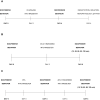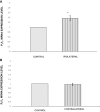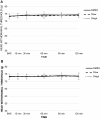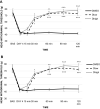P2Y2 Receptors Mediate Masseter Muscle Mechanical Hypersensitivity in Rats
- PMID: 32581574
- PMCID: PMC7280063
- DOI: 10.2147/JPR.S239831
P2Y2 Receptors Mediate Masseter Muscle Mechanical Hypersensitivity in Rats
Abstract
Purpose: P2Y2 receptors (P2Y2Rs) are among the various receptors that play an important role in nociception. The goal of this research was to investigate possible P2Y2R expression changes in the trigeminal ganglion (TRG) in bilateral masseter muscle (MM) hypersensitivity following unilateral MM inflammation. The impact of unilateral intramasseteric administration of P2Y2R antagonist on bilateral MM hypersensitivity was also explored.
Materials and methods: Bilateral MM hypersensitivity was provoked by unilateral intramasseteric injection of complete Freund's adjuvant (CFA). The head withdrawal threshold (HWT) was assessed bilaterally 4 days later. Bilateral TRG and MM isolation were followed, and quantitative real-time polymerase chain reaction (qRT-PCR) and histopathological analysis were carried out on these tissues, respectively. The involvement of P2Y2Rs in nocifensive behavior was evaluated by administering two doses of P2Y2R antagonist AR-C118925 (0.2 or 1 mg/100 μL) in inflamed MM 4 days post-CFA administration. Bilateral HWT was assessed at different time points following antagonist injection.
Results: qRT-PCR analysis demonstrated P2Y2R up-regulation in TRG ipsilateral to the site of CFA administration. Compared to the controls, both doses of AR-C118925 injected ipsilateral to the TRG increased the bilateral HWT at 30, 60, 90, and 120 minutes after antagonist administration.
Conclusion: The findings suggest that P2Y2Rs may affect MM inflammatory hypersensitivity owing to its up-regulation in the TRG in MM inflammatory pain states.
Keywords: facial pain; masticatory muscles; temporomandibular disorders; trigeminal ganglion.
© 2020 Tariba Knežević et al.
Conflict of interest statement
The authors report no conflicts of interest in this work.
Figures





Similar articles
-
Therapeutic potential for P2Y2 receptor antagonism.Purinergic Signal. 2023 Jun;19(2):401-420. doi: 10.1007/s11302-022-09900-3. Epub 2022 Oct 11. Purinergic Signal. 2023. PMID: 36219327 Free PMC article. Review.
-
The role of P2X3 receptors in bilateral masseter muscle allodynia in rats.Croat Med J. 2016 Dec 31;57(6):530-539. doi: 10.3325/cmj.2016.57.530. Croat Med J. 2016. PMID: 28051277 Free PMC article.
-
TRPV1 channel-mediated bilateral allodynia induced by unilateral masseter muscle inflammation in rats.Mol Pain. 2013 Dec 30;9:68. doi: 10.1186/1744-8069-9-68. Mol Pain. 2013. PMID: 24377488 Free PMC article.
-
Temporomandibular joint inflammation potentiates the excitability of trigeminal root ganglion neurons innervating the facial skin in rats.J Neurophysiol. 2005 May;93(5):2723-38. doi: 10.1152/jn.00631.2004. Epub 2004 Dec 29. J Neurophysiol. 2005. PMID: 15625101
-
Activation of NK1 receptor of trigeminal root ganglion via substance P paracrine mechanism contributes to the mechanical allodynia in the temporomandibular joint inflammation in rats.Pain. 2005 Aug;116(3):375-385. doi: 10.1016/j.pain.2005.05.007. Pain. 2005. PMID: 15985331
Cited by
-
Therapeutic potential for P2Y2 receptor antagonism.Purinergic Signal. 2023 Jun;19(2):401-420. doi: 10.1007/s11302-022-09900-3. Epub 2022 Oct 11. Purinergic Signal. 2023. PMID: 36219327 Free PMC article. Review.
-
Structural insight into the self-activation and G-protein coupling of P2Y2 receptor.Cell Discov. 2025 May 13;11(1):47. doi: 10.1038/s41421-025-00797-x. Cell Discov. 2025. PMID: 40360475 Free PMC article.
-
Preclinical models of deep craniofacial nociception and temporomandibular disorder pain.Jpn Dent Sci Rev. 2021 Nov;57:231-241. doi: 10.1016/j.jdsr.2021.10.002. Epub 2021 Nov 12. Jpn Dent Sci Rev. 2021. PMID: 34815817 Free PMC article. Review.
-
Peripheral Purinergic Modulation in Pediatric Orofacial Inflammatory Pain Affects Brainstem Nitroxidergic System: A Translational Research.Biomed Res Int. 2022 Mar 11;2022:1326885. doi: 10.1155/2022/1326885. eCollection 2022. Biomed Res Int. 2022. PMID: 35309172 Free PMC article.
References
-
- Dworkin SF, LeResche L. Research diagnostic criteria for temporomandibular disorders: review, criteria, examinations and specifications, critique. J Craniomandib Disord. 1992;6(4):301–355. - PubMed
-
- Bäck K, Hakeberg M, Wide U, Hange D, Dahlström L. Orofacial pain and its relationship with oral health-related quality of life and psychological distress in middle-aged women. Acta Odontol Scand. 2019;1–7. - PubMed
-
- Quinelato V, Bonato LL, Vieira AR, Granjeiro JM, Tesch R, Casado PL. Association between polymorphisms in the genes of estrogen receptors and the presence of temporomandibular disorders and chronic arthralgia. J Oral Maxillofac Surg. 2018;76(2):314.e1–314.e9. doi:10.1016/j.joms.2017.10.023 - DOI - PubMed
LinkOut - more resources
Full Text Sources
Research Materials

